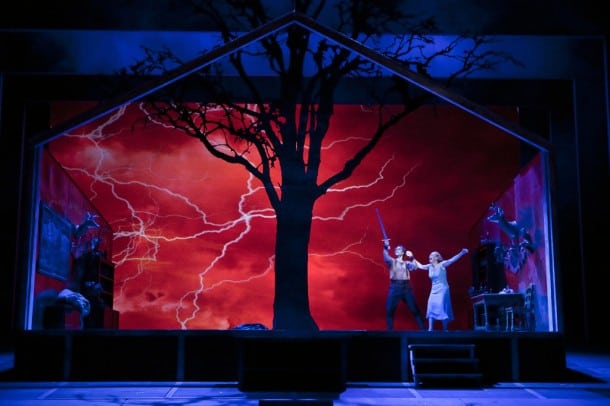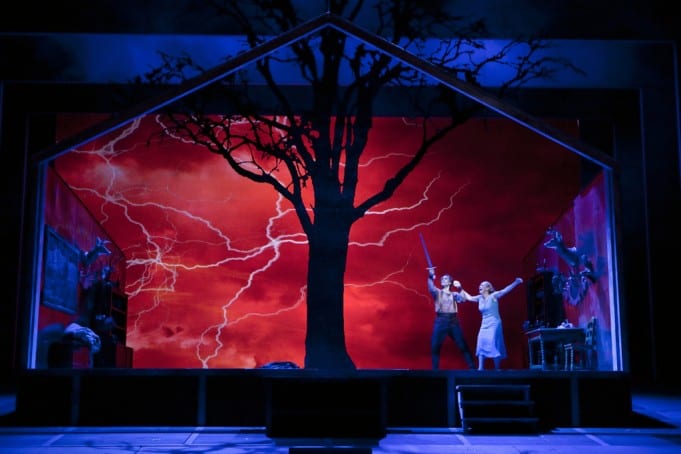This is part 2 (Die Walküre) of a four-part review series of The Ring of the Nibelung, one of the biggest stage presentations this year in the San Francisco Bay Area. Part 1 (Das Rheingold) can be read here. Note that Lord of the Rings was also based on this material.

Die Walküre is the most difficult of the Ring operas: difficult to appreciate with its many-layered nuances, difficult to sit through and difficult to emotionally process, holding us in its bleak grasp as we watch characters buffeted by the inevitability of the Nordic fates. While light moments do exist, such as when the charismatic Brunhilde (Nina Stemme) infuses the set with all the certainty and enthusiasm of youth, those moments are few and far between, and don’t begin to counterbalance the heaviness of the rest of the production. However, it’s the heart of these lighter moments are what we cling to most as they give some meaning to this grim twilight of the idols.
Die Walküre opens when Siegmund (Brandon Jovanvich) passes out in front of the home of Sieglinde (Heidi Melton) and Hunding (Daniel Sumegi), wounded and exhausted. The sensitivity of Heidi Melton’s acting was matched only by the maestro Donald Runnicles delicate touch. This scene is informed by understatement, both in the orchestra pit and on stage. The slightest hesitation of a hand on the door and the hint of drawn out strings convey more meaning than much of the bombast found in later sections.
Preparing for this, I was struck by how familiar the first act seemed until I turned to a well-thumbed copy of Saga of the Volsung sitting on my shelves, A single vellum manuscript dating to approximately 1400 is our source of this tale, which predates the manuscript by eight hundred odd years. In the Saga of the Volsung, a one-eyed stranger thrusts the sword into Barnstock, the huge tree in the Volsong palace, saying “he who draws this sword out of the trunk shall receive from me as a gift and he himself shall prove he has never carried a better sword than this one.” So begins the Volsung saga, in which Sigmund wins the sword and mates with his sister Signy (who has shapeshifted into someone else). Thumbing through the Volsung Saga , which is far more wideranging and bloody than the operatic version, I was stunned at Wagner’s self-restraint in reining in his source material to a mere four hours and 30 minutes.
This production was slightly different from the June 2010 version of the same. The first act flew by in 2010, yet seemed protracted last night. The converse is true with the fight scene under the bridge, which seemed startling in its brevity last night. While the fabulous sets were identical, they were used differently: parachutes drop at different angles and the fight scene under the overpass seems less out of West Side Story.
Of note – and perhaps slightly more obvious in this version than in 2010, is the use of photographs of the dead heroes. The use of image, and the manipulation of the same resonate deeply. The inescapability from these images harkens to Komeini’s aggressive reproduction and manipulation of images of martyrs during the Iran-Iraq war when photos of these young men appeared everywhere. Through them we create a world that is difficult to escape from, not unlike the downfall of these gods.
Nina Stemme, who was fabulous in the 2010 production, managed to even outdo herself last night, as did Mark Delavan as Wotan. Toward the end, Delavan’s voice seems to weaken and I wondered if he was losing stamina – before realizing that insofar as gods age, we were literally watching him ravaged by time. Whereas in Das Rhinegold, he leapt nimbly with Loge, asserting his power across the stage in Neibelheim, here we see him struggling to stand, awkwardly going down on a knee, so broken that at points, his voice is overcome by the orchestra.
We get a day off from the Ring tomorrow – and Wotan can recover a bit – before the five hour Seigfried on Friday.
Summer 2011 Ring – The Ring of the Nibelung
Part 2 – Die Walküre
By Richard Wagner5 out of 5 stars – Outstanding
San Francisco Opera
Conductor – Donald Runnicles
Director – Francesca ZambelloBrunhilde – Nina Stemme
Wotan – Mark Delavan
Siegelinde – Heidi Melton
Siegmund – Brandon Jonovich
Photo credit: Cory Weaver.



